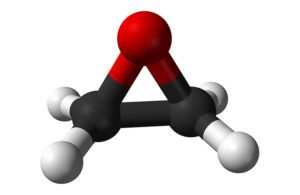
Model of an ethylene oxide molecule.
This article has been updated with comments from Medline Industries.
People who live about a mile away from a Medline device sterilization plant in Waukegan, Ill. have blood levels of the cancer-causing gas ethylene oxide that are about 50% higher than those who live farther away, according to a report by WebMD and Georgia Health News.
Environmental health researchers from the University of Illinois at Chicago (UIC) tested 93 people who responded to fliers and social media posts about the research, the report said. Because the participants were not randomly selected, the results may be biased and have not been published in a peer-reviewed medical journal.
Nevertheless, they represent the first biologic evidence that living near an EtO plant increases the amount of the chemical in the body, the report said. The Centers for Disease Control (CDC) funded the study, and its Agency for Toxic Substances and Disease Registry will include the results in health reports it is compiling for people who live near EtO plants in Illinois and Covington, Ga., the report said.
The researchers suggested that the federal government conduct more carefully controlled research to better determine the risk to residents who live near EtO plants, the report added.
The Environmental Protection Agency is expected to update its regulation of EtO in 2020. The crisis over medtech sterilization using EtO began in February 2019, when a Sterigenics EtO plant in Willowbrook, Ill. was shut down by state officials. Since then, two other facilities were shut down in Georgia, although one has reopened. Viant signed a consent agreement last week with the state of Michigan to stop using EtO at its plant in Grand Rapids.
Medline assembles and sterilizes approximately 16,000 custom surgical kits per day at the Waukegan plant, which is located in Chicago’s northern suburbs. The company has operated the surgical kit manufacturing and sterilization plant the same way for the past 25 years, company spokesman Jesse Greenberg told Medical Design & Outsourcing in October.
“Since the raw data, methodology or official summary from the UIC researchers has not been released, we are left with a lot of questions about what conclusions, if any, can be drawn from this limited sampling,” Greenberg said in an email today. “What we do know is that recent ambient air tests released by the Lake County Health Department show EtO levels at sites closest to Medline in Waukegan are below background levels the EPA measured in 34 different cities. Also, Medline regularly administers blood tests for Waukegan employees and has never found evidence of elevated EtO levels in 25 years. Even so we are continuing to make our facility safer by installing best available emissions control technology that will capture 99.9% of all EtO. Once our upgrades are complete, our facility will operate the most advanced safety equipment in the world.”
EtO is used to sterilize about 50% of all devices sold in the U.S. that require sterilization — more than 20 billion medical devices per year, according to the FDA. It is a preferred sterilant for devices made from certain polymers (such as plastic or resin), metals, or glass, and devices that have multiple layers of packaging or hard-to-reach crevices, because it has better penetration properties than other methods and is unlikely to damage products during the process.
Medela (McHenry, Ill.), which makes breast pumps and other devices for nursing mothers and newborns, said it made the Medline Waukegan plant its primary sterilization source after Illinois state regulators shut down Sterigenics’ EO plant in Willowbrook, Ill. in February. The Medline Waukegan plant now sterilizes “millions of pieces of medical devices” for Medela, the company said in October.
In addition to Medline, Illinois’ Lake County includes a non-medtech user of EtO. Vantage Specialty Chemicals has a facility in Gurnee, Ill, that uses ethylene oxide to make household and industrial products.


